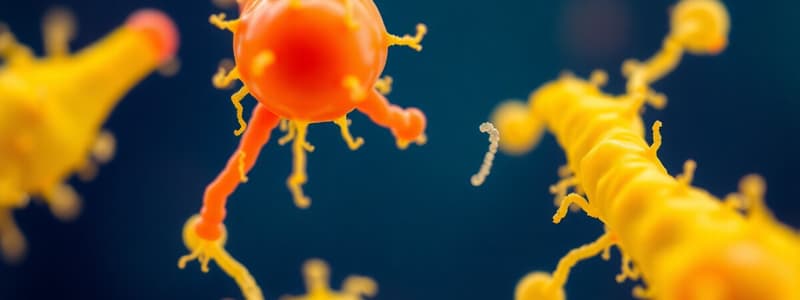Podcast
Questions and Answers
What is the main function of peptidoglycan in bacterial cells?
What is the main function of peptidoglycan in bacterial cells?
- Facilitates genetic material replication
- Provides a food source for the bacteria
- Acts as a semipermeable membrane
- Maintains cell shape and provides rigidity (correct)
What structural element is associated with teichoic acids in gram-positive bacteria?
What structural element is associated with teichoic acids in gram-positive bacteria?
- Cytoplasmic membrane
- Outer polysaccharide layer
- Periplasmic space
- Peptidoglycan layer (correct)
Which characteristic is unique to the cytoplasmic membrane in bacterial cells?
Which characteristic is unique to the cytoplasmic membrane in bacterial cells?
- It is impermeable to all solutes
- It contains ribosomes for protein synthesis
- It is exclusively found in gram-negative bacteria
- It separates the cytoplasm from the cell wall (correct)
Which statement correctly describes the function of the mesosomes in bacteria?
Which statement correctly describes the function of the mesosomes in bacteria?
Teichoic acids contribute to which aspect of gram-positive bacteria?
Teichoic acids contribute to which aspect of gram-positive bacteria?
What is located in the periplasmic space of bacterial cells?
What is located in the periplasmic space of bacterial cells?
Which component is NOT found in bacterial ribosomes?
Which component is NOT found in bacterial ribosomes?
Which of the following options is true regarding the O antigen of certain gram-negative bacteria?
Which of the following options is true regarding the O antigen of certain gram-negative bacteria?
What characteristic distinguishes prokaryotic DNA from eukaryotic DNA?
What characteristic distinguishes prokaryotic DNA from eukaryotic DNA?
Which of the following statements about capsules is correct?
Which of the following statements about capsules is correct?
What is the primary function of pili in bacteria?
What is the primary function of pili in bacteria?
Flagella are primarily involved in which of the following processes?
Flagella are primarily involved in which of the following processes?
Which scientist is credited with introducing the principles of fermentation for food preservation?
Which scientist is credited with introducing the principles of fermentation for food preservation?
What role do bacterial spores play in the survival of bacteria?
What role do bacterial spores play in the survival of bacteria?
Which of the following is NOT a feature of prokaryotic cells?
Which of the following is NOT a feature of prokaryotic cells?
Who is recognized as the 'Father of Immunology' for developing the first vaccine?
Who is recognized as the 'Father of Immunology' for developing the first vaccine?
How do capsular polysaccharides contribute to vaccine development?
How do capsular polysaccharides contribute to vaccine development?
Which of the following organisms did Robert Koch NOT discover?
Which of the following organisms did Robert Koch NOT discover?
What distinguishes flagella from pili in bacterial cells?
What distinguishes flagella from pili in bacterial cells?
What method did Robert Koch introduce for the isolation of bacteria?
What method did Robert Koch introduce for the isolation of bacteria?
Who discovered penicillin?
Who discovered penicillin?
Which taxonomic category is immediately below 'Family' in the hierarchy of classification?
Which taxonomic category is immediately below 'Family' in the hierarchy of classification?
Which of the following statements is true about scientific nomenclature?
Which of the following statements is true about scientific nomenclature?
What key concept did Louis Pasteur contribute to microbiology?
What key concept did Louis Pasteur contribute to microbiology?
What is a key structural difference between gram-positive and gram-negative bacteria?
What is a key structural difference between gram-positive and gram-negative bacteria?
Which of the following accurately describes the function of the outer membrane in gram-negative bacteria?
Which of the following accurately describes the function of the outer membrane in gram-negative bacteria?
What is the role of lipid A in lipopolysaccharide (LPS)?
What is the role of lipid A in lipopolysaccharide (LPS)?
Which statement about teichoic acid is correct?
Which statement about teichoic acid is correct?
What characterizes the outer membrane of gram-negative bacteria?
What characterizes the outer membrane of gram-negative bacteria?
Which of the following is true regarding the periplasmic space in gram-negative bacteria?
Which of the following is true regarding the periplasmic space in gram-negative bacteria?
Which of the following is NOT a function of the bacterial cell membrane?
Which of the following is NOT a function of the bacterial cell membrane?
What distinguishes exotoxins from endotoxins?
What distinguishes exotoxins from endotoxins?
Which of the following characteristics is unique to viruses compared to bacteria, fungi, and parasites?
Which of the following characteristics is unique to viruses compared to bacteria, fungi, and parasites?
What is the main reproductive method used by bacteria?
What is the main reproductive method used by bacteria?
Which type of nucleic acid can be found in both fungi and parasites?
Which type of nucleic acid can be found in both fungi and parasites?
Which category do prions and viroids belong to?
Which category do prions and viroids belong to?
Which of the following statements about cellular microbes is accurate?
Which of the following statements about cellular microbes is accurate?
What characteristic distinguishes eukaryotes from prokaryotes?
What characteristic distinguishes eukaryotes from prokaryotes?
In which of the following environments are viruses generally considered to be permanent residents?
In which of the following environments are viruses generally considered to be permanent residents?
What type of organism is characterized as being multicellular and having a true nucleus?
What type of organism is characterized as being multicellular and having a true nucleus?
Flashcards are hidden until you start studying
Study Notes
Microbes
- Microbes can be categorized as cellular and acellular.
- Cellular microbes include bacteria, archaea, fungi, and protists.
- Acellular microbes include viruses, prions, and viroids.
Normal Microbial Flora
- Normal microbial flora are permanent residents of the body.
- Found in areas like skin, mouth, nose, colon, and vagina.
- Composed of non-pathogenic bacteria and yeasts.
- Internal organs are sterile.
Scientific Nomenclature
- Carolus Linnaeus introduced the two-part naming system.
- First part is the genus, written with a capital letter.
- Second part is the species, written in lowercase.
- Both genus and species are written in italics.
History of Microbiology
- Antony van Leeuwenhoek - Invented the first microscope and observed microorganisms.
- Louis Pasteur - Known as the "Father of Microbiology".
- Studied fermentation.
- Introduced sterilization techniques.
- Developed pasteurization.
- Contributed to vaccine development.
- Postulated the "germ theory of disease".
- Robert Koch - Known as the "Father of Bacteriology."
- Received the Nobel Prize for discovering the tubercle bacilli.
- Introduced solid media for culturing bacteria.
- Developed methods for isolating bacteria in pure cultures.
- Introduced staining techniques.
- Described Koch's postulates and phenomenon.
- Edward Jenner - Known as the "Father of Immunology."
- Developed the first vaccine for smallpox.
- Alexander Fleming - Discovered penicillin.
- Selman Waksman - Discovered streptomycin.
- Charles Chamberland - Discovered viruses and their role in disease.
Bacterial Structure
- Outer Membrane
- Found only in Gram-negative bacteria.
- Acts as a barrier.
- Composed of lipopolysaccharide (LPS) and phospholipids.
- LPS acts as an endotoxin, causing fever and shock.
- Peptidoglycan
- A complex network surrounding the entire cell.
- Provides structural support and maintains cell shape.
- Found only in bacterial cell walls.
- Teichoic Acid
- Found in the outer layer of Gram-positive cell walls.
- Can induce septic shock.
- Mediate attachment of bacteria to mucosal cells.
- Cytoplasmic Membrane
- Present in both Gram-positive and Gram-negative bacteria.
- Acts as a semipermeable membrane, controlling the flow of molecules.
- Cytoplasm
- A colloidal system containing various solutes, including water, salts, and proteins.
- Rich in ribosomes, DNA, and fluid.
- Mesosomes
- Invaginations of the plasma membrane.
- Increase membrane surface area for enzyme activity and transport.
- May participate in cell replication.
- Periplasmic Space
- The space between the cell membrane and cell wall.
- Contains enzymes and proteins, including chemoreceptors.
- Ribosomes
- Centers of protein synthesis.
- Slightly smaller than eukaryotic ribosomes.
- Nucleus
- Area where DNA is located.
- Prokaryotic DNA is a single, circular molecule.
- No nuclear membrane, nucleolus, mitotic spindle, or histones.
- Granules
- Storage areas for nutrients.
- Capsule
- Gelatinous layer covering the entire bacterium.
- Composed of polysaccharide.
- Plays a role in:
- Virulence (limits phagocytosis).
- Specific identification.
- Vaccine development.
- Adherence to human tissues.
- Pili (Fimbriae)
- Hair-like filaments extending from the cell surface.
- Shorter and straighter than flagella.
- Composed of pilin protein.
- Used for:
- Attachment to target cells or surfaces.
- DNA transfer during conjugation.
- Flagella
- Long, whip-like appendages for movement.
- Composed of flagellin protein.
- Enable chemotaxis (movement towards nutrients).
- Spores
- Highly resistant structures formed in response to adverse conditions.
- Extremely resistant to heat and chemicals.
Studying That Suits You
Use AI to generate personalized quizzes and flashcards to suit your learning preferences.




